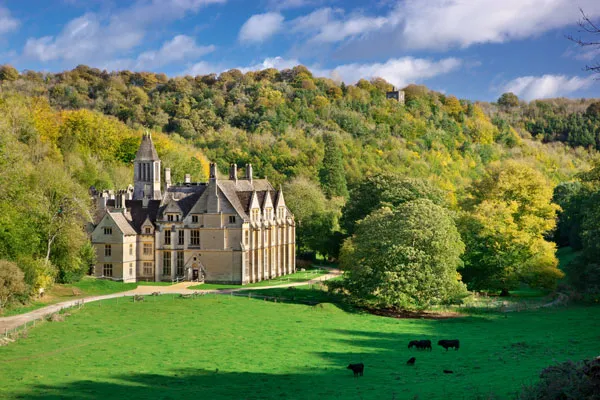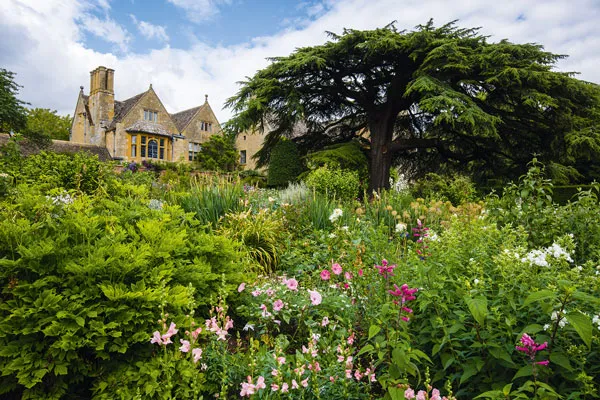Few areas of Britain boast a more imposing collection of country houses than the Cotswolds. There is a very good reason for this: from medieval times, these rolling hills, straddling six English counties, were one of the wealthiest areas in the country.
The prosperity came from sheep – particularly the Cotswold Lion breed, famous for its rich fleece. Buyers came from all over Europe to purchase the highly prized wool. Soon, a spin-off industry in cloth-making thrived in the Cotswolds, too. Landowners and clothiers became rich, and their wealth was displayed in their luxurious homes.
One of the oldest and certainly one of the most picturesque of these homes is Owlpen Manor, which lies at one end of a deep green valley near the village of Uley.
The manor’s slightly odd name is a version of the name of the de Olepenne family, who had a house here in medieval times. In 1464, Margery de Olepenne married John Daunt; most of what we see today dates from changes made by the Daunt family, starting in the middle of the 16th century.

©National Trust images
The approach to the front of the house leads up a flight of semicircular steps. From this vantage point it is at once apparent that the property has grown and changed over the years. The hall and great chamber at the heart of the house date from about 1540 and the west wing was added in 1616. The medieval east wing is original, but was given an 18th-century makeover with the addition of sash windows.
These differing styles are unified by two things: yes, everything is grand; but at the same time, together the separate elements comprise a comfortable home. This is especially obvious once you have stepped inside the house. There is a fine Tudor fireplace, but the real treasures are the painted 17th-century wall hangings. You’ll see nothing quite like them in any other house in Britain. The house is currently only open to bookings of 15 or more people, but it’s well worth the trouble of organising a trip if you can.
Tudor treasure trove
The village of Snowshill is everything a Cotswold village should be, full of attractive stone cottages and surrounded by gently rolling pastures dotted with sheep. But it is the manor house at its heart that draws in visitors. Snowshill Manor sits comfortably in its surroundings, with its old stone walls, gabled roof and mullioned windows. Like Owlpen, much has changed over the years: the manor belonged to Winchcombe Abbey until 1539; it was rebuilt around 1600 and altered again in the 18th century. It is an attractive house in a lovely setting, and these virtues alone make it worth visiting. What makes it unmissable, however, is its last great transformation, wrought when Charles Wade bought the property in 1919.
An artist and architect, Wade set about restoring the house, with its maze of rooms, to which he often gave strange names, such as Dragon and Seraphim. He then began to fill them and the surrounding outbuildings with his collection of extraordinary objects.

©National Trust images
It seems there was no end to what Wade would collect. Some seem appropriate to the region: models of brightly painted farm wagons and tools from Cotswold industries such as lace-making. But why is there a collection of ship models and nautical memorabilia – in the middle of the countryside? And the greatest surprise comes when you walk into a room to be confronted by suits of Japanese Samurai armour. Snowshill is a place of wonders.
Grand glass house
Where our first two houses were homely, Stanway House is Grand with a capital G. It all starts with the incredibly ornate 17th-century gatehouse, three storeys high with lodges to either side and decorated with lovely, fluted columns.
A first glimpse of the house itself takes the breath away. Where most houses in the area have modest mullioned windows, Stanway has huge expanses of glass. Obviously this does a good job of lighting the interior, but this is a statement about wealth. Glass was a luxury in Jacobean times, and to have this much installed must have cost a fortune.
Everything about this house and its grounds is there to impress. Open parkland stretches away from the house, dotted with sturdy oaks, before at last giving way to fields; but arguably the most imposing feature of all can be found in the water garden. Here the fountain dominates everything. At the top of the hill above the house is a reservoir holding 100,000 gallons of water, which feeds the fountain via a mile-and-a-half long pipe. By the time it reaches the bottom of the hill, the water is under such pressure that when the valves are opened, a jet of water shoots straight up, 91m (300ft) into the air – the highest jet fountain in the country.
There is also a more modest but charming feature in the grounds. The cricket ground has a little thatched pavilion, donated to the estate and village by the author of Peter Pan, JM Barrie.
Morris ex machina
The old houses of the Cotswolds appeal largely through their simple architectural forms – gables and mullioned windows – and their use of materials: Cotswold stone walls and stone tile roofs. This combination of faithful craftsmanship and local materials had a special appeal for the burgeoning Arts and Crafts movement of the 19th century.
One of the most important figures in the movement was the writer and designer William Morris, who found the ‘machine age’ abhorrent and who wanted to return to the craftsmanship of earlier times. He looked for simplicity and honesty of workmanship. He famously wrote: “Have nothing in your house that you do not know to be useful, or believe to be beautiful.”
When Morris leased Kelmscott Manor in 1871, he followed his own advice. One can see just why Kelmscott appealed to him: this is an archetypal Cotswold country house, set on a quiet lane near a tiny village. To him, it was the “‘loveliest haunt of ancient peace”. Begun in 1570 and enlarged the following century, it lies a stone’s throw from the Thames: if you can, leave time to stroll along its willow-fringed banks. Although a manor house, Kelmscott had been home to generations of yeomen farmers, and when Morris obtained it he also acquired some of their solid oak furniture and tapestries.
Everything about the interior speaks of the period. Morris shared it at first with the Pre-Raphaelite artist Dante Gabriel Rossetti, and the latter’s portrait of Morris’s wife Jane, with the house in the background, still hangs here. But the main appeal lies in the furniture and fittings: the wallpapers and curtains designed by Morris, furniture from architect and designer Philip Webb and other craftsmen. There are also some odd quirks – such as the staircase with alternating treads, each one made to take just one foot. Today, with our modern devices, much might seem not especially useful, but everything is undeniably beautiful.
The leaders of the Arts and Crafts movement were not content with renovating old buildings. They also commissioned new works, but specified they should be built in traditional style. Anyone interested in the movement should certainly visit Rodmarton Manor, built for the Biddulph family between 1909-1929. All the furniture was specially made for the house, designed by such famous craftsmen as Sidney and Edward Barnsley, and it is full of artefacts and craft works of the period. It is a perfect example of everything this movement stood for.
Abandoned manor
Visiting these splendid houses, you might be curious to know how they were built. One edifice provides that insight. In 1845, William Leigh purchased the Woodchester estate, which included an extensive park and a house called Spring Park Mansion, set near the head of a long wooded valley. His first idea was to restore the mansion, but as it was in too poor a state, he decided to pull it down and build a new, far bigger house.
Work on Woodchester Mansion began in the 1850s. It was to be a house on the grandest scale, built in Cotswold limestone in the Revival Gothic style with French influence. When Leigh died in 1873, the house was still unfinished. His son looked at the cost of completing the building, and simply abandoned the project. The mansion still stands, looking much as it was when the builders moved out. Stepping inside is quite an extraordinary experience; one can look right up to the arches supporting the roof. There is the slightly surreal sight of fireplaces high above you, but no floors.
Woodchester Mansion is – or would have been – a grandiose structure. Yet in contrast, one of the features that makes most Cotswold houses so attractive is their lack of pretension. One of the most visited group of houses is Arlington Row in Bibury (“the most beautiful village in England,” said William Morris). These beautiful cottages were once occupied by handloom weavers. Here are just the same materials, the same gabled frontages and mullioned windows.
The country house and the worker’s cottage may be vastly different in scale, but they share the same roots. It is this sense of continuity that gives the Cotswold houses, large and small, their enduring appeal.
Anthony Burton lives in the Cotswolds and is the author of many walking guides and books on the countryside, including the official guide to The Cotswold Way.
